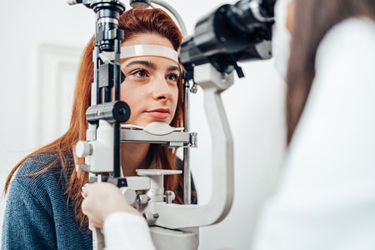Inside The Trials Aiming To Stop Vision Loss For Rare Eye Disease Patients
A conversation with Ocugen’s CMO, Huma Qamar, MD, MPH, CMI

Today, nearly 99% of individuals living with retinitis pigmentosa (RP) have no approved treatment options. Ocugen aims to change that by developing a novel modifier gene therapy that offers the potential to not only preserve vision but to restore it.
Unlike traditional gene therapies that focus on gene editing or replacement, Ocugen’s modifier gene therapy introduces an entirely new concept. Rather than targeting the defective gene alone, the modifier gene therapy approach upregulates a network of healthy genes to counteract the mutation, restore cellular homeostasis, and create a supportive environment for retinal cells to function and survive.
In this Q&A, Ocugen Chief Medical Officer Huma Qamar, MD, MPH, CMI, discusses two trials — the Phase 3 OCU400 liMeliGhT clinical trial for RP and the Phase 2/3 OCU410ST clinical trial for Stargardt disease — and how they’ve managed their protocol design, PI selection, and patient recruitment.
Clinical Leader: How are your investigational drugs’ potential communicated to patients or potential participants?
Huma Qamar, MD, MPH, CMI: Refining this concept took several years — particularly with patients in mind. Today, patients are well-informed; many understand their clinical condition better than anyone else. However, once diagnosed, they often face uncertainty about what steps to take next.
For the Phase 3 OCU400 liMeliGhT clinical trial, we’ve adopted a broader, gene-agnostic approach. This means patients are eligible for treatment regardless of the specific genetic mutation causing their RP. To support this gene-agnostic mechanism, the study includes two arms: one for patients with the RHO gene mutation (75 patients) and another for those with any RP-related mutation (75 patients). In each group, 50 patients receive the study drug while 25 serve as controls. After one year, we plan to offer treatment to the control group as well.
This is also a two-in-one randomization design — patients may receive treatment in both eyes if they qualify. If not, the worse-affected eye is dosed first. Our core goal is to preserve whatever vision patients still have. Ideally, we hope to go beyond preservation and see actual improvement or restoration.
Patients often ask, “Can this stop disease progression?” Our answer is: yes — this treatment has the potential to do that.
In our patient testimonials — from both the OCU400 (RP) and OCU410ST (Stargardt disease) programs — we’ve heard inspiring stories. Some patients not only experienced stabilization but also improvements in peripheral vision and night navigation. For instance, patients who could once take only two steps in dim light are now confidently taking six. Others have gained two lines or 10 letters on the vision chart within six months, an outcome previously thought impossible. That is what we call clinically meaningful improvement — it’s not just a number; it’s a meaningful enhancement in their quality of life.
How does OCU410ST fit in with the current treatment landscape for Stargardt?
There is no approved product for Stargardt disease. OCU410ST has a unique four-way mechanism of action. Other approaches target only the complement system and do not address the additional pathways that are part of the disease pathophysiology — namely, inflammation (a hallmark of gene therapy), oxidative stress, and lipid metabolism. Our preclinical data demonstrated meaningful impact across all four pathways.
Stargardt disease is characterized by over 1,200 mutations in the ABCA4 gene. OCU410ST has received FDA Orphan Drug designation for all ABCA4-related retinopathies. We recently secured FDA alignment on our Phase 2/3 pivotal confirmatory trial design — accelerating clinical development by two to three years.
We plan to file the BLA in 2027, which — if achieved — would make us the first company to leverage an adaptive design to reach this milestone. Our interim analysis will include 24 subjects (16 treated, eight controls) and our overall enrollment target for the pivotal study is 51 subjects (34 treated, 17 controls).
Tell me about the adaptive trial design. How did you decide this was the best path?
The OCU401ST Phase 2/3 clinical trial design will not only help achieve efficiencies in cost and other valuable resources, more importantly, we believe it will yield clinically meaningful and statistically significant data. We have established the safety and tolerability profile in our Phase 1 study, which followed a standard 3+3 dose-escalation design. This included low, medium, and high dose cohorts, allowing us to determine the maximum tolerated dose. Notably, there have been no serious adverse events and no cases of inflammation directly attributed to the investigational product.
Once we established the maximum tolerable dose, we advanced to the Phase 2/3 trial, where 34 patients in the treatment group will receive OCU410ST administration and 17 patients will serve as controls. Only one dose level is being used in this phase. The trial includes both adult and pediatric patients — as young as 5 years old — and includes patients with early to advanced cases of Stargardt disease severity. Consistent with our OCU400 trial design, the worse eye is dosed first in the OCU410ST trial.
The adaptive trial design accelerates approval as we included prespecified interim analysis that help guide modifications such as adjusting sample size and offers flexibility to identify early signals of efficacy and/or safety. Once we confirmed the maximum tolerated dose in Phase 1, we seamlessly transitioned into Phase 2/3 using a single effective dose, which eliminated the need for a separate dose finding Phase 2 study, saving time and resources.
In ophthalmologic trials, is it typical to split treatment for control on one eye and treatment on the other?
Control doesn't mean placebo or sham procedure. In our trials, one eye receives the treatment, while the other eye serves as a control. This approach leverages the natural course of the disease, as there's no contralateral effect observed in these conditions. For analysis, we compare all treated eyes against all untreated eyes across the study population.
However, it is important to note that disease progression can continue in the untreated eye during the trial period. For Stargardt disease (OCU410ST), we are dosing only one eye initially. Once the data is locked at the end of the study (nearly one year), we will assess the eligibility of the second eye for dosing pending confirmation of eligibility based on the health and structural integrity. This staggered approach allows us to ensure safety and preserve function in both eyes over time.
How did you choose your investigators, and what level of familiarity do they need to have with administering this investigative drug?
In gene therapy trials, the surgeons make or break the study. You might have an excellent product, but the success of the program hinges on the skill and precision of the surgical team. There are only a limited number of vitreoretinal surgeons in the United States, and even fewer are trained specifically in gene therapy procedures — it’s an entirely different ball game.
During our Phase 1/2 OCU400 trial for RP, we partnered with some of the top institutions. These surgeons not only had extensive experience with complex retinal surgeries, but they also understood the nuances of delivering gene therapy. They're innovative, but at the same time, extremely cautious when it comes to patients’ safety and tolerance.
It wasn’t easy, but we now have a group of top-notch key opinion leaders and highly skilled vitreoretinal surgeons behind this program. We have a rigorous process for ongoing education and training. New surgeons are onboarded through a structured program, often mentored by master surgeons who’ve led previous trials. It’s a robust and disciplined approach, because in gene therapy, every detail matters.
Understanding the heterogeneity of the diseases, how do you select trial endpoints that are meaningful for the science and to the patients?
Let’s talk about RP and our OCU400 program, which is currently in Phase 3. The FDA not only focuses on the pathophysiology of the disease but also on how treatment outcomes are meaningful for patients. The primary endpoint is functional, and that’s been a major point of discussion with the agency. Our mobility test met the threshold at greater than two lux levels, which was key for establishing efficacy. The secondary endpoints are also functional, such as low-luminance visual acuity, where patients read a vision chart under dim lighting conditions. The FDA ultimately cares about real-world improvements: If a patient can read, drive, or navigate using vision, that’s what matters most.
For Stargardt disease and the OCU410ST program, functional endpoints are considered secondary. These patients suffer from central vision loss, with a bullseye pattern of degeneration, flecks, and geographic atrophy. Patients experience blurriness and haziness and are at high risk of vision loss. Since there’s currently no approved treatment for Stargardt and it's classified as a rare disease, regulatory agencies show some flexibility. In this case, the atrophic lesion size can serve as the primary endpoint, with functional measures as secondary. Regardless, two things remain critical: the data must be clinically meaningful and statistically significant.
Finally, how will this one-time treatment will be monitored post-approval?
If we receive approval for OCU401ST in 2027, we will conduct an additional four years of safety follow-up for these patients. This is the general expectation from regulatory agencies for gene therapies and is part of the required pharmacovigilance activities. After four years of collecting safety data and fulfilling these pharmacovigilance requirements, no additional clinical trials will be needed in Europe. If we provide sufficient supporting evidence in the U.S., approval in Europe is likely to be concurrent.
About The Expert:
 Huma Qamar, MD, MPH, CMI, is the Chief Medical Officer for Ocugen, a pioneering biotechnology leader in gene therapies for blindness diseases. In her role, she oversees clinical development and medical operations, including mid- to late-stage clinical trials for Ocugen’s novel modifier gene therapy platform, which has the potential to treat multiple retinal diseases. Dr. Qamar has extensive experience in clinical research, having worked at institutions such as Yale, Harvard, and the University of Pennsylvania.
Huma Qamar, MD, MPH, CMI, is the Chief Medical Officer for Ocugen, a pioneering biotechnology leader in gene therapies for blindness diseases. In her role, she oversees clinical development and medical operations, including mid- to late-stage clinical trials for Ocugen’s novel modifier gene therapy platform, which has the potential to treat multiple retinal diseases. Dr. Qamar has extensive experience in clinical research, having worked at institutions such as Yale, Harvard, and the University of Pennsylvania.
